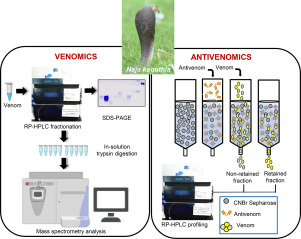当前位置:
X-MOL 学术
›
J. Proteomics
›
论文详情
Our official English website, www.x-mol.net, welcomes your
feedback! (Note: you will need to create a separate account there.)
Proteomics of Naja kaouthia venom from North East India and assessment of Indian polyvalent antivenom by third generation antivenomics.
Journal of Proteomics ( IF 2.8 ) Pub Date : 2019-07-22 , DOI: 10.1016/j.jprot.2019.103463 Archana Deka 1 , Aditi Gogoi 1 , Diganta Das 2 , Jayaditya Purkayastha 3 , Robin Doley 1
Journal of Proteomics ( IF 2.8 ) Pub Date : 2019-07-22 , DOI: 10.1016/j.jprot.2019.103463 Archana Deka 1 , Aditi Gogoi 1 , Diganta Das 2 , Jayaditya Purkayastha 3 , Robin Doley 1
Affiliation

|
In the present study, venom composition, toxic effects, and immunological characteristics of Naja kaouthia venom from North East India has been studied. Using RP-HPLC, venom components were separated and proteins in the fractions were identified using ESI-LC MS/MS. Proteins identified belong to 9 different snake venom protein families. Three finger toxins and PLA2 were the most abundant protein families detected by mass spectrometry analysis. The other minor proteins families identified in the venom were kunitz-type serine inhibitors, waprin, L-amino acid oxidase, CRISP, vespyrn, nerve growth factor and metalloproteinase. This proteome composition correlated with the tested enzymatic and toxic activities of the venom. Western blot and third generation antivenomics analysis using Vins polyvalent antivenom revealed immunoreactivity towards Naja kaouthia venom of North East India. Concentration-dependent immunocapturing profile carried out using RP-HPLC displayed immunerecognition of majority of venom proteins of Naja kaouthia except few three-finger toxins. Presence of such non-immunodepleted toxins apparently may affect the performance of Vins polyvalent antivenom. Thus, inclusion of antibodies of most relevant non-immunorecognized toxins in antivenom might help to improve the quality of antivenom. BIOLOGICAL SIGNIFICANCE: Envenomings by genus Naja, represent a serious medical problem in Asian countries including North east India. In North East India, Naja kaouthia is most prevalent cobra species causing a large number of fatalities. To gain deeper insight into the spectrum of medically relevant toxins, we applied proteomics approach to unveil the proteome profile of Naja kaouthia venom. The proteomic analysis divulged the presence of two major protein families: three finger toxins and phospholipases A2. In general, polyvalent antivenom is administered for Naja kaouthia envenomings, however, this venom is not included in the immunization mixtures (only Indian Big Four venoms) for production of these polyvalent antivenoms. For the first time, third generation antivenomics approach was used to decipher maximal binding capacity of Indian polyvalent antivenom against Naja kaouthia venom. Although Vins polyvalent antivenom was effective in immunocapturing majority of venom components, however, large amount of antivenom was required to immunocapture the venom proteins. Moreover, the study revealed poor immunorecognition capacity of Vins antivenom towards four three finger toxin subtypes. This may have significant impact on antivenom efficacy in treating Naja kaouthia envenomings.
中文翻译:

来自印度东北部的Naja kaouthia毒液的蛋白质组学和通过第三代抗药性对印度多价抗蛇毒素的评估。
在本研究中,已经研究了来自印度东北部的眼镜蛇毒液的毒液成分,毒性作用和免疫学特征。使用RP-HPLC分离毒液成分,并使用ESI-LC MS / MS鉴定级分中的蛋白质。鉴定出的蛋白质属于9种不同的蛇毒蛋白质家族。质谱分析检测到三指毒素和PLA2是最丰富的蛋白质家族。在毒液中鉴定出的其他次要蛋白质家族是kunitz型丝氨酸抑制剂,waprin,L-氨基酸氧化酶,CRISP,vespyrn,神经生长因子和金属蛋白酶。该蛋白质组组成与毒液的酶活性和毒性活动相关。使用Vins多价抗蛇毒血清的Western印迹和第三代抗蛇毒血清学分析表明,其对印度东北部的眼镜蛇毒液具有免疫反应性。使用RP-HPLC进行的浓度依赖性免疫捕获图谱显示,除了少量的三指毒素外,大多数眼镜蛇毒液蛋白都具有免疫识别能力。此类未免疫去除的毒素的存在显然可能会影响Vins多价抗蛇毒的性能。因此,在抗蛇毒血清中包含最相关的非免疫识别毒素的抗体可能有助于提高抗蛇毒的质量。生物学意义:眼镜蛇属的毒液代表了包括印度东北部在内的亚洲国家中的严重医学问题。在印度东北部,眼镜蛇斑纹眼镜蛇是最常见的眼镜蛇物种,造成大量死亡。为了更深入地了解医学上相关毒素的光谱,我们应用了蛋白质组学方法来揭示眼镜蛇毒的蛋白质组图谱。蛋白质组学分析揭示了两个主要蛋白质家族的存在:三种手指毒素和磷脂酶A2。通常,眼镜蛇眼镜蛇毒被使用多价抗蛇毒子,但是,用于生产这些多价抗蛇毒子的免疫混合物(仅印度大四毒)中不包括这种毒蛇。第一次,第三代抗药性方法用于破译印度多价抗毒剂对眼镜蛇毒的最大结合能力。尽管Vins多价抗蛇毒蛋白可以有效地捕获大多数毒液成分,但仍需要大量抗蛇毒蛋白来免疫捕获蛇毒蛋白。而且,该研究表明,Vins antivenom对四种三指毒素亚型的免疫识别能力较弱。这可能对抗蛇毒成分在治疗眼镜蛇毒蛇毒中的效果产生重大影响。
更新日期:2019-07-22
中文翻译:

来自印度东北部的Naja kaouthia毒液的蛋白质组学和通过第三代抗药性对印度多价抗蛇毒素的评估。
在本研究中,已经研究了来自印度东北部的眼镜蛇毒液的毒液成分,毒性作用和免疫学特征。使用RP-HPLC分离毒液成分,并使用ESI-LC MS / MS鉴定级分中的蛋白质。鉴定出的蛋白质属于9种不同的蛇毒蛋白质家族。质谱分析检测到三指毒素和PLA2是最丰富的蛋白质家族。在毒液中鉴定出的其他次要蛋白质家族是kunitz型丝氨酸抑制剂,waprin,L-氨基酸氧化酶,CRISP,vespyrn,神经生长因子和金属蛋白酶。该蛋白质组组成与毒液的酶活性和毒性活动相关。使用Vins多价抗蛇毒血清的Western印迹和第三代抗蛇毒血清学分析表明,其对印度东北部的眼镜蛇毒液具有免疫反应性。使用RP-HPLC进行的浓度依赖性免疫捕获图谱显示,除了少量的三指毒素外,大多数眼镜蛇毒液蛋白都具有免疫识别能力。此类未免疫去除的毒素的存在显然可能会影响Vins多价抗蛇毒的性能。因此,在抗蛇毒血清中包含最相关的非免疫识别毒素的抗体可能有助于提高抗蛇毒的质量。生物学意义:眼镜蛇属的毒液代表了包括印度东北部在内的亚洲国家中的严重医学问题。在印度东北部,眼镜蛇斑纹眼镜蛇是最常见的眼镜蛇物种,造成大量死亡。为了更深入地了解医学上相关毒素的光谱,我们应用了蛋白质组学方法来揭示眼镜蛇毒的蛋白质组图谱。蛋白质组学分析揭示了两个主要蛋白质家族的存在:三种手指毒素和磷脂酶A2。通常,眼镜蛇眼镜蛇毒被使用多价抗蛇毒子,但是,用于生产这些多价抗蛇毒子的免疫混合物(仅印度大四毒)中不包括这种毒蛇。第一次,第三代抗药性方法用于破译印度多价抗毒剂对眼镜蛇毒的最大结合能力。尽管Vins多价抗蛇毒蛋白可以有效地捕获大多数毒液成分,但仍需要大量抗蛇毒蛋白来免疫捕获蛇毒蛋白。而且,该研究表明,Vins antivenom对四种三指毒素亚型的免疫识别能力较弱。这可能对抗蛇毒成分在治疗眼镜蛇毒蛇毒中的效果产生重大影响。


















































 京公网安备 11010802027423号
京公网安备 11010802027423号